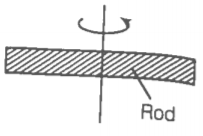A uniform metallic rod rotates about its perpendicular bisector with the constant angular speed. If it is heated uniformly to raise its temperature slightly,
1. its speed of rotation increases
2. its speed of rotation decreases
3. its speed of rotation remains the same
4. its speed increases because its moment of inertia increases


© 2025 GoodEd Technologies Pvt. Ltd.